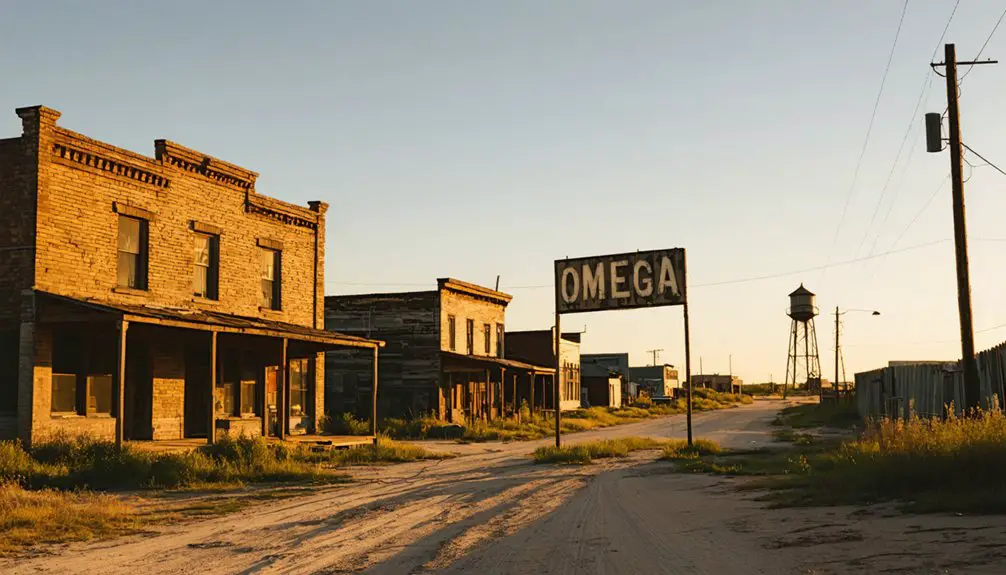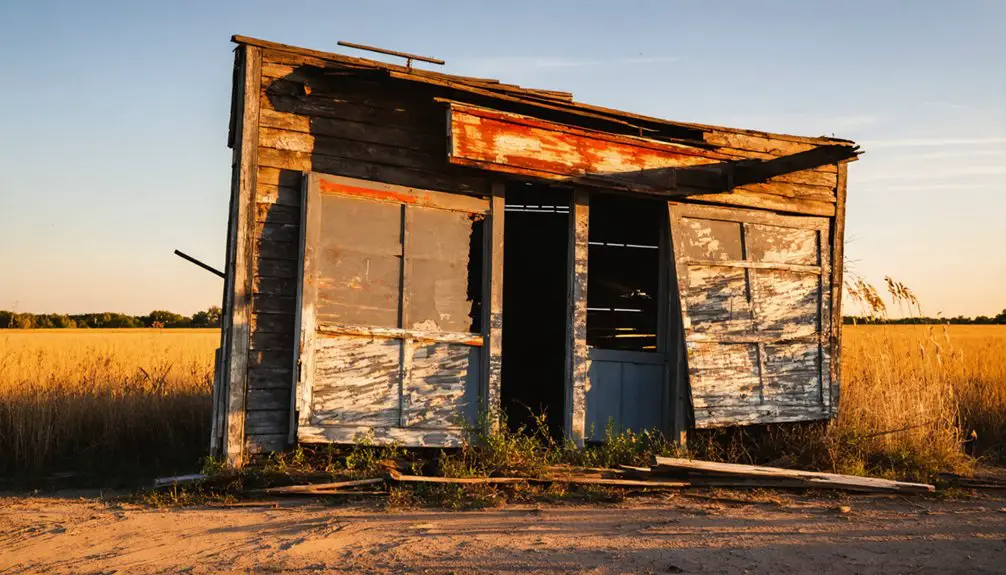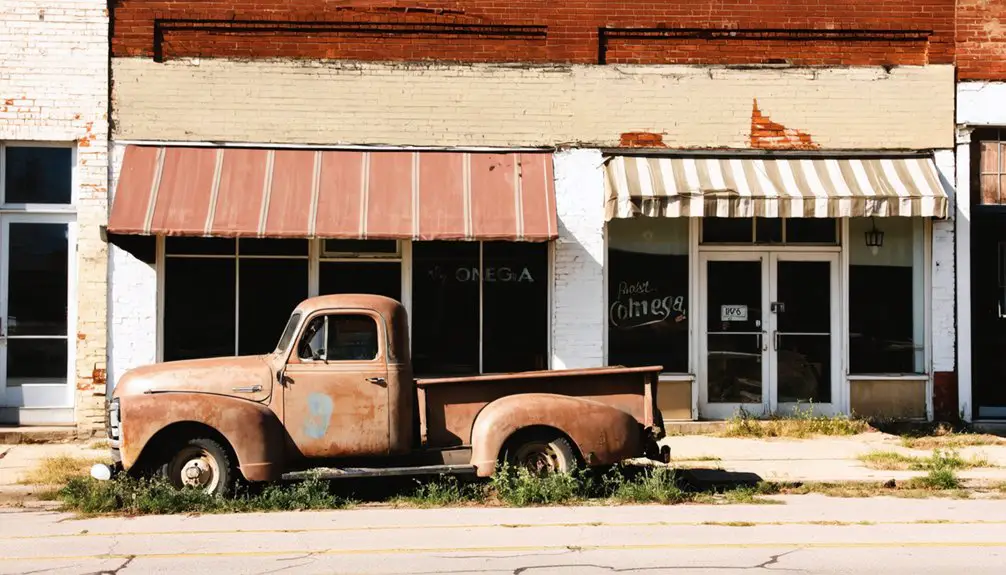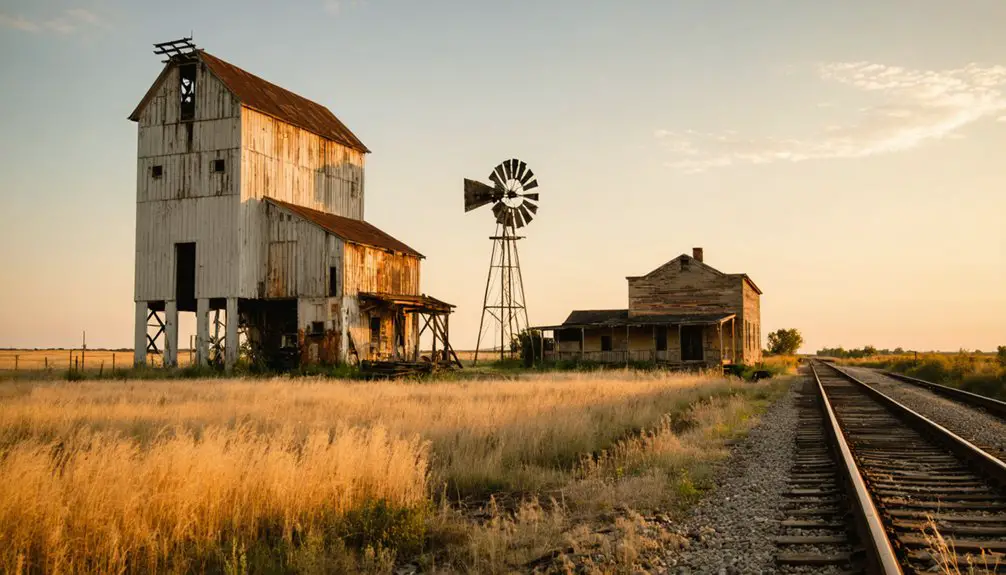You’ll find Omega in Kingfisher County, Oklahoma, where it emerged during the late 19th-century settlement wave. The town flourished briefly due to agriculture and nearby oil discoveries, with its daily life centered around the general store, post office, and church. Today, you can explore crumbling structures and overgrown foundations that reveal the footprint of this frontier community. Omega’s haunting remnants hold fascinating stories of boom, bust, and the pioneering spirit of Oklahoma’s past.
Key Takeaways
- Omega was established in Kingfisher County, Oklahoma, during the late 19th century as a frontier town near State Highway 3.
- The town experienced brief prosperity from agriculture and nearby oil discoveries before declining during the Great Depression.
- Only crumbling structures, foundations, and scattered remnants remain of the once-thriving community’s commercial buildings and homes.
- Economic instability, population exodus to larger cities, and lack of sustainable resources contributed to Omega becoming a ghost town.
- The abandoned town’s physical remains include weather-worn signs, old farming equipment, and overgrown buildings showcasing Oklahoma’s rural history.
Origins and Early Settlement
Located in Kingfisher County, Oklahoma, Omega emerged as a small frontier settlement during the late 19th to early 20th century territorial period.
You’ll find this Class D town positioned strategically near the county line, just west of Kingfisher city and a couple miles north of State Highway 3.
The town’s establishment coincided with Oklahoma’s broader settlement wave, when pioneers faced settlement challenges while carving out new communities from the frontier.
Like many boomtowns after statehood, Omega developed rapidly due to the discovery of local resources before eventually declining.
Today, only crumbling structures remain, serving as silent reminders of the once-thriving community.
Omega’s unique identity emerged through its connection with nearby Alpha, as the towns were named after the first and last letters of the Greek alphabet.
The community dynamics centered around agricultural pursuits, with early settlers developing farmland and establishing basic services to meet local needs.
This strategic positioning near transportation routes helped support the town’s early development and trade connections.
Life in Frontier Omega
As settlers established their roots in Omega, daily life took shape around agriculture and tight-knit community bonds. You’d find residents working together during planting and harvest seasons, sharing tools and labor to guarantee everyone’s survival. The Chicago Kansas Railway brought crucial transportation access to the region.
Community gatherings at the general store, post office, and church strengthened social connections despite the harsh frontier conditions.
Agricultural practices defined the town’s rhythm, with families adapting to:
- Seasonal demands of crop cultivation and livestock management
- Weather challenges that required collective problem-solving
- Bartering systems for essential goods and services
- Community events like dances and church socials that provided vital emotional support
You’d see simple wood-frame and sod homes dotting the landscape, with public buildings centrally located to serve as gathering spots for this freedom-loving frontier community. Like many settlements that emerged during the land runs, Omega’s establishment reflected the pioneering spirit of Oklahoma’s territorial expansion.
The Twin Towns: Omega and Alpha

While many frontier settlements stood alone against the challenges of early Oklahoma Territory, Omega formed a unique partnership with its sister town Alpha, creating what settlers knew as the “twin towns.”
You’d find these settlements strategically positioned near each other, sharing essential resources and forging economic bonds that helped both communities thrive in their early years.
The twin symbolism of Omega and Alpha reflected deeper cultural connections among settlers, who chose these Greek letters to represent completion and new beginnings. Similar to how brotherly love healed divisions in post-Civil War America, the twin towns demonstrated how cooperation could strengthen frontier communities.
The settlements’ defensive configuration mirrored the historic Twin Villages fortifications along the Red River that had protected Native American communities.
You’ll recognize how their interdependence shaped daily life – when one town hosted community events, both populations would participate.
Trade flowed freely between them, with each settlement often specializing in complementary services.
This partnership lasted until economic changes ultimately led to Omega’s decline into its current ghost town status.
Economic Rise and Fall
You’ll find that Omega’s early economic story centered on modest agricultural pursuits and the hopes of securing a railroad connection to boost trade.
While the railroad dreams never materialized, leaving the town without this vital transportation link, the discovery of oil in nearby Osage County would soon transform Omega’s fortunes. Like many towns during the Great Depression, Omega saw its population dwindle as economic hardship took its toll.
The ensuing oil boom brought dramatic population growth and newfound prosperity, though this wealth would prove temporary as the region’s petroleum resources eventually depleted. Like many Oklahoma oil settlements, the town faced challenges with dangerous working conditions in the oilfields where workers routinely risked their lives during drilling operations.
Early Agriculture and Trade
Three key agricultural developments shaped Omega’s early economic growth: the introduction of advanced cultivation methods, the establishment of farm-to-market roads, and the emergence of local trade networks.
You’ll find that settlers embraced crop diversification and livestock management to combat the harsh Great Plains environment, while building a resilient local economy through strategic trading partnerships.
The town’s agricultural success relied on:
- Advanced farming techniques using chemical fertilizers and improved seed varieties
- Local general stores serving as crucial exchange points for produce and supplies
- Strategic crop rotation and seasonal livestock raising to minimize environmental risks
- Establishment of trade relationships with neighboring communities, including Alpha
These agricultural foundations helped Omega thrive initially as a regional trade center, though its prosperity remained closely tied to the land’s productivity and market accessibility.
Railroad Dreams Unfulfilled
As Omega’s agricultural prosperity grew in the early 1900s, residents pinned their hopes on the Oklahoma Central Railroad (OCR) to transform their town into a major regional hub. The OCR’s planned railroad expansion promised to connect Omega’s farmers with broader markets, carrying their cotton, livestock, and other goods across the territory. Oklahoma’s rich history as a cattle trade center along the Chisholm Trail made railway access especially appealing to local ranchers.
But you wouldn’t have found long-term success in these railroad dreams. The OCR, established in 1904, struggled against fierce economic competition from larger railways like the Missouri-Kansas-Texas and the St. Louis-San Francisco.
These established lines had deeper pockets and more extensive routes. While the OCR managed to lay 127 miles of track from Lehigh to Chickasha, it couldn’t sustain profitability. The railroad’s financial troubles became evident when it went into receivership in June 1908, forcing a major reorganization of its operations.
Population and Prosperity Shifts
The failed railroad dreams paralleled a larger story of economic evolution in Omega.
You’ll find that population dynamics followed a familiar pattern seen in many agricultural communities of that era – initial growth fueled by German and German-Russian immigrants in the late 1800s, followed by decline after 1930.
The economic changes that shaped Omega’s destiny centered around these key factors:
- Agricultural prosperity initially drew settlers, with the population reaching its peak during Oklahoma’s statehood in 1907.
- German-Russian immigrants brought essential wheat cultivation expertise that boosted the local economy.
- Mechanization after 1930 reduced farm labor needs, triggering rural exodus.
- The region’s shift from small family farms to consolidated operations sealed Omega’s fate.
These changes transformed a once-thriving farming community into today’s ghost town, reflecting the broader story of America’s changing rural landscape.
Abandonment and Decline
Once a bustling community during Oklahoma’s early development, Omega’s decline followed patterns seen in thousands of ghost towns across the state.
Like many of its counterparts, you’ll find that changing social dynamics and shifting economic policies stripped away the town’s liveliness, leaving behind mere shadows of its former prosperity.
As transportation routes evolved and younger residents sought opportunities in larger cities, Omega’s population dwindled greatly.
You can trace its abandonment to the classic boom-and-bust cycle that affected countless Oklahoma communities.
Without a sustainable economic base to retain its workforce, the town couldn’t maintain its essential services or infrastructure.
The aging population and reduced birth rates further accelerated the decline, leading to a near-complete exodus that transformed this once-thriving settlement into another of Oklahoma’s 2,000+ ghost towns.
Physical Remnants Today

Modern visitors to Omega’s silent streets will encounter scattered evidence of the town’s past life. Urban decay has transformed this once-vibrant community into a haunting tableau of weathered structures and historical artifacts.
You’ll find original houses, commercial buildings, and brick chimneys standing defiantly against time, while nature steadily reclaims the landscape.
- Crumbling foundations reveal the town’s original footprint, offering glimpses into past residents’ daily lives
- Weather-worn signs and discarded tools tell stories of local commerce and agriculture
- Overgrown vegetation conceals treasures like old farming equipment and household items
- Wooden structures, though dangerous to enter, serve as time capsules of Oklahoma’s frontier spirit
The site’s untamed character beckons explorers, but exercise caution – unstable structures and uneven terrain demand respect.
Historical Significance in Kingfisher County
Omega’s establishment near the Kingfisher County line illustrates the rapid development of rural communities following Oklahoma Territory’s 1890 organization.
You’ll find that Omega emerged as one of many small agricultural settlements that dotted the county’s landscape during the land run era, serving local farming families and contributing to the region’s agrarian economy.
While the town’s location along primitive transport routes initially supported its growth, the absence of railroad connections likely contributed to its eventual decline as commerce shifted to better-connected communities.
Early Settlement Patterns
Prior to becoming part of Oklahoma Territory, the land that would encompass Kingfisher County held deep historical significance as home to numerous Native American tribes, including the Wichita, Comanche, Plains Apache, Osage, and Quapaw peoples.
The social dynamics and settlement geography of the region transformed dramatically after the Land Run of 1889, when the federal government opened the Unassigned Lands for non-Indian settlement.
You’ll find that several key factors shaped the early settlement patterns:
- The Chisholm Trail’s proximity influenced where people chose to establish homesteads
- Railroad development, particularly the Kansas and Nebraska Railway, determined town locations
- Trading posts and stage stations created natural gathering points for communities
- Ethnic clustering and freedmen settlements contributed to diverse population distribution
These patterns laid the foundation for Omega’s eventual development and decline.
Agriculture and Railroad Impact
During the late 19th and early 20th centuries, the convergence of railroad expansion and agricultural development transformed Kingfisher County’s economic landscape.
You’ll find that Omega, situated 18 miles west of Kingfisher, initially benefited from this transformation as railroad networks enhanced crop transportation of wheat, corn, and cotton to broader markets.
Railroad competition played a significant role in determining the fate of small towns like Omega.
While the rail lines initially attracted settlers and businesses, creating essential links between rural communities and economic hubs, they’d later contribute to the town’s decline.
When rail routes shifted or service reduced, Omega’s agricultural producers lost efficient market access.
The subsequent technological changes in farming, combined with natural disasters like the 1930s Dust Bowl, accelerated the town’s transformation into a ghost town.
Legacy and Cultural Impact

Though many ghost towns dot Oklahoma’s landscape, the legacy of Omega stands as a compelling symbol to the state’s dynamic settlement patterns and cultural evolution.
You’ll find that this small Kingfisher County settlement, paired with its sister town Alpha, contributed greatly to the region’s cultural narratives and heritage awareness.
- Omega’s remnants tell the story of frontier ambition and the challenges faced by early Oklahoma settlers.
- The town’s unique “twin city” naming convention with Alpha reflects the creative spirit of territorial expansion.
- Its preservation efforts help maintain essential connections to Oklahoma’s rural past.
- As a historical landmark, you’ll see how Omega continues to shape regional identity through educational initiatives and heritage tourism.
These elements collectively preserve Omega’s importance in Oklahoma’s rich tapestry of abandoned settlements, ensuring its story endures for future generations.
Frequently Asked Questions
Are There Any Reported Ghost Stories or Paranormal Activities in Omega?
You won’t find documented ghost sightings or paranormal investigations in the area. Historical records and local archives don’t mention any supernatural occurrences, making it a quiet ghost town focused on heritage.
What Was the Highest Recorded Population of Omega During Its Peak?
Time fades all things. You’ll find no exact peak population records, but given Omega’s historical significance and typical population decline patterns of Oklahoma ghost towns, estimates suggest several hundred residents maximum.
Did Any Notable Historical Figures or Events Originate From Omega?
You won’t find any notable historical figures or significant events from Omega. The town’s historical significance remained minimal, lacking key landmarks or documented achievements worth preserving in Oklahoma’s historical record.
Can Visitors Legally Explore the Remaining Structures in Omega Today?
You’ll need to exercise caution, as legal restrictions likely apply to most remaining structures. Due to visitor safety concerns and private property laws, you must obtain permission before exploring any buildings.
Were There Any Churches, Schools, or Post Offices in Omega?
You’ll find minimal church history and school legacy records, but there’s confirmation of a post office that served the community from 1892 until its closure in 2009.
References
- https://en.wikipedia.org/wiki/List_of_ghost_towns_in_Oklahoma
- https://kids.kiddle.co/List_of_ghost_towns_in_Oklahoma
- https://freepages.rootsweb.com/~gtusa/history/usa/ok.htm
- https://www.okhistory.org/publications/enc/entry?entry=KI012
- https://therockerbox.com/kingfisher_county_ok_ghost_towns.htm
- https://okmag.com/blog/a-ghostly-site/
- https://www.okhistory.org/publications/enc/entry?entry=GH002
- https://www.ghosttownsinoklahoma.com/post/ghosttownsinoklahomaintroduction
- https://ato.org/home/ato-history/
- https://www.okhistory.org/publications/enc/entry?entry=TW005



